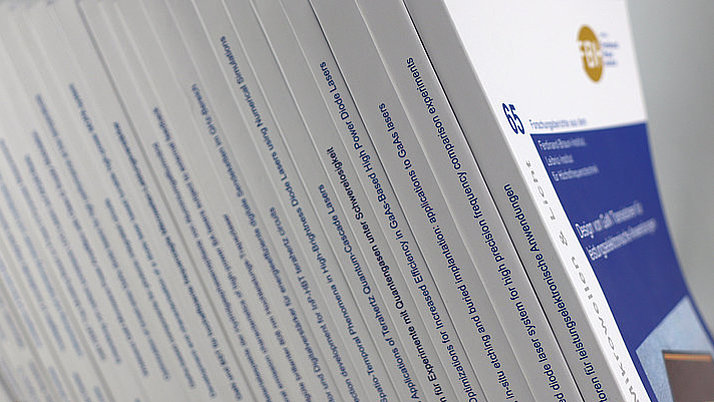Spectrally pure far-UVC emission from AlGaN-based LEDs with dielectric band pass filters
M. Guttmann1,2, N. Lobo-Ploch2, H. Gundlach3, F. Mehnke1, L. Sulmoni1, T. Wernicke1, H.K. Cho2, K. Hilbrich2, A. Külberg2, M. Friedler2, T. Filler2, I. Käpplinger4, D. Mitrenga4, C. Maier4, O. Brodersen4, T. Ortlepp4, U. Woggon3, S. Einfeldt2 and M. Kneissl1,2
Published in:
J. Phys. D: Appl. Phys., vol. 55, no. 20, pp. 205105, doi:10.1088/1361-6463/ac5145 (2022).
Abstract:
AlGaN-based far ultraviolet-C (UVC) light emitting diodes (LEDs) with a peak emission wavelength below 240 nm typically show a long-wavelength tail at >240 nm that is detrimental to the use of the devices for skin-friendly antisepsis. We present the development of far-UVC LEDs with reduced long-wavelength emission using a HfO2/SiO2-based distributed Bragg reflector (DBR) filter. When the DBR filter is directly mounted on an LED package, the long-wavelength emission around 250 nm is reduced by two orders of magnitude while the transmitted output power is reduced down to 18%-27% of the initial value for DBR filters with cut-off wavelengths at 237-243 nm. As the transmission through the DBR filter depends strongly on the angle of incidence of the radiation, the transmitted output power of the spectrally pure far-UVC radiation can be doubled when an additional collimating lens is used on top of the LED package before passing through the filter.
1 Institute of Solid State Physics, Technische Universität Berlin, Hardenbergstraße 36, 10623 Berlin, Germany
2 Ferdinand-Braun-Institut gGmbH, Leibniz-Institut für Höchstfrequenztechnik, Gustav-Kirchhoff-Str. 4, 12489 Berlin, Germany
3 Institute of Optics and Atomic Physics, Technische Universität Berlin, Straße des 17. Juni 135, 10623 Berlin, Germany
4 CiS Forschungsinstitut für Mikrosensorik GmbH, Konrad-Zuse-Str. 14, 99099 Erfurt, Germany
Keywords:
far-UVC, LED, AlGaN, spectral purity, dielectric filter, HfO2/SiO2
Copyright © 2022 The Author(s). Published by IOP Publishing Ltd.
Original content from this work may be used under the terms of the Creative Commons Attribution 4.0 licence. Any further distribution of this work must maintain attribution to the author(s) and the title of the work, journal citation and DOI.
Full version in pdf-format.


